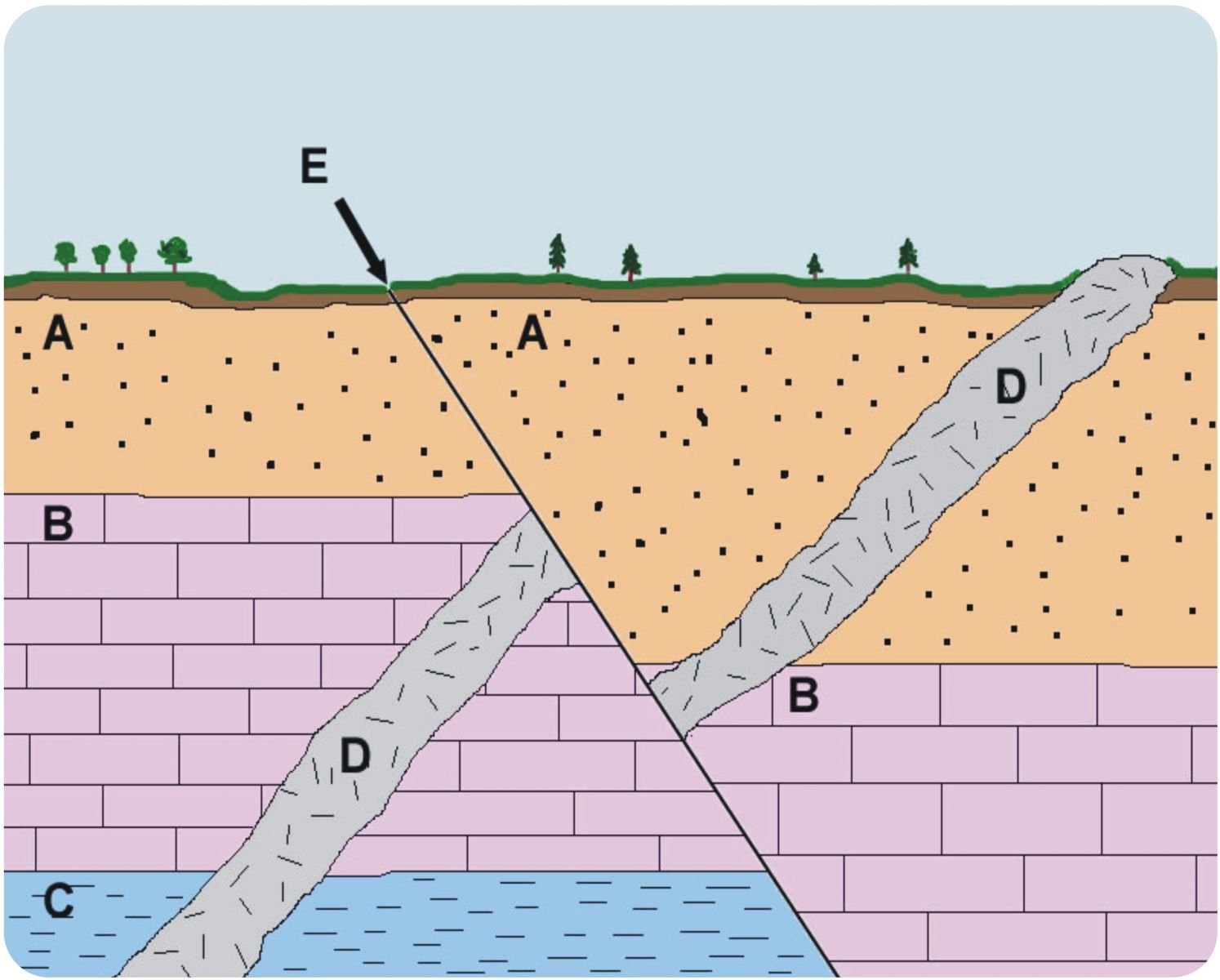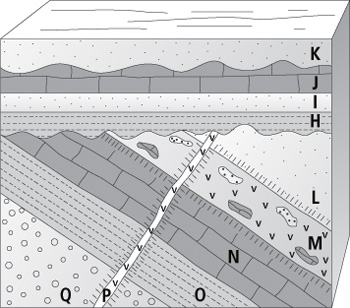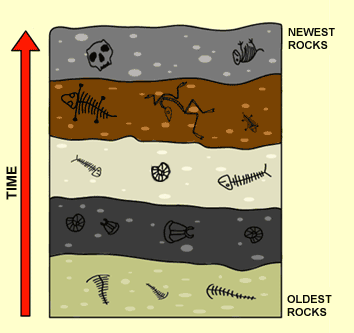Geological History Of Earth! Trivia Questions Quiz
Explore the fascinating geological history of Earth with this trivia quiz! Test your knowledge on rock layers, geological features, and the sequence of their formation. Perfect for learners interested in Earth sciences and geology.
(157).jpg)
Quiz Preview
- 2.
Fossils are usually found in which type of rock?
-
Metamorphic
-
Extrusive Igneous
-
Sedimentary
-
Intrusive Igneous
Correct Answer
A. SedimentaryExplanation
Fossils are usually found in sedimentary rock because this type of rock is formed from layers of sediment that accumulate over time. Fossils are formed when the remains of plants and animals become trapped in the sediment and are preserved over millions of years. Sedimentary rock is also often found in areas where there was once a body of water, such as oceans or lakes, which provides the ideal conditions for fossil formation. Therefore, sedimentary rock is the most likely type of rock to contain fossils.Rate this question:
-
- 3.
Consider a fault that cuts through all the layers of a rock-layer sequence. Is the fault older or younger than the layers?
-
Older
-
Younger
Correct Answer
A. YoungerExplanation
The fault is younger than the layers because faults are formed by the movement and displacement of rocks. In this case, the fault cuts through all the layers of the rock-layer sequence, indicating that it occurred after the layers were already deposited. Therefore, the fault is considered to be younger than the layers.Rate this question:
-
- 4.
Unless a series of sedimentary rock layers have been overturned, the bottom rock layer usually
-
Contains the greatest variety of minerals
-
Contains fossils
-
Has the finest texture
-
is the oldest
Correct Answer
A. is the oldestExplanation
The correct answer is "is the oldest." In sedimentary rock layers, new layers are deposited on top of older layers over time. Therefore, the bottom layer is the oldest, as it was the first layer to be formed.Rate this question:
-
- 5.
What is the feature at letter "E" called?
-
Tilting
-
Intrusion
-
Folding
-
Fault
Correct Answer
A. FaultExplanation
The feature at letter "E" is called a fault.Rate this question:
-
- 6.
Which layer was formed first?
-
Q
-
P
-
K
-
M
Correct Answer
A. Q -
- 7.
What is feature "P"?
-
Intrusion
-
Extrusion
-
Cross-Bedding
-
Unconformity
Correct Answer
A. IntrusionExplanation
The correct answer is "Intrusion" because an intrusion refers to the process of magma or molten rock forcing its way into pre-existing rocks and solidifying underground. This process creates intrusive igneous rocks, such as granite, which have a coarse-grained texture due to the slow cooling of the magma. Intrusions can take various forms, including sills, dikes, and batholiths, and they are an important geological feature that helps scientists understand the history and composition of the Earth's crust.Rate this question:
-
- 8.
Determinng whether an object of event is older or younger than other objects or events is called
-
Absolute Date
-
Carbon dating
-
Radiometric Dating
-
Relative Dating
-
None of the above
Correct Answer
A. Relative DatingExplanation
Relative dating is the correct answer because it refers to the process of determining the age of an object or event in relation to other objects or events. It does not provide an exact or absolute date but instead establishes a sequence or order of events. This method is commonly used in archaeology and geology to understand the chronological order of artifacts, fossils, and rock layers.Rate this question:
-
- 9.
What geologic principle states that in an undisturbed rock sequence, the oldest rocks are on the bottom and the youngest are on the top?
-
Uniformitarianism
-
Superposition
-
Original horizontality
-
Cross-cutting relationships
Correct Answer
A. SuperpositionExplanation
Superposition is the geologic principle that states in an undisturbed rock sequence, the oldest rocks are found at the bottom while the youngest rocks are located at the top. This principle is based on the idea that sedimentary layers are deposited horizontally over time, with each new layer being younger than the one beneath it. As a result, the lower layers have had more time to accumulate and are therefore older than the layers above them. This principle is fundamental in determining the relative ages of rock layers and fossils in stratigraphy.Rate this question:
-
- 10.
Which is older, Layer M or Layer P
-
Layer M
-
Layer P
-
Same Age
-
Neither
Correct Answer
A. Layer MExplanation
The given question is asking about the age comparison between Layer M and Layer P. The answer states that Layer M is older, implying that Layer P is younger or was formed after Layer M.Rate this question:
-
- 11.
Which radioactive substance would probably be used in dating the recent remains of a plant found in sedimentary deposits?
-
Potassium-40
-
Uranium-238
-
Carbon-14
-
Thorium-232
Correct Answer
A. Carbon-14Explanation
Carbon-14 is the most suitable radioactive substance for dating the recent remains of a plant found in sedimentary deposits. This is because carbon-14 is an isotope of carbon that is present in the atmosphere and absorbed by plants during photosynthesis. When the plant dies, it no longer takes in carbon-14, and the isotope begins to decay at a known rate. By measuring the amount of carbon-14 remaining in the plant's remains, scientists can determine the age of the plant and the sedimentary deposit it was found in. Potassium-40, uranium-238, and thorium-232 are not commonly used for dating recent remains of plants.Rate this question:
-
- 12.
A fossil of an organism that lived during a relatively short geological time and over a wide geographic area is called a
-
Trace fossil
-
Phacops
-
Index fossil
-
Tropites
Correct Answer
A. Index fossilExplanation
An index fossil is a fossil of an organism that lived during a relatively short geological time and over a wide geographic area. It is used by geologists to determine the age of rock layers and correlate them across different locations. Index fossils are particularly useful because they are easily recognizable, abundant, and have a wide distribution. They provide a way for scientists to date and correlate rock layers, helping to establish the relative ages of different geological formations.Rate this question:
-
- 13.
The principle of _________ states that an intrusion or fault is younger than the rocks it cuts across.
-
Superposition
-
Uniformitarianism
-
Cross-cutting relationships
-
Original horizontality
Correct Answer
A. Cross-cutting relationshipsExplanation
Cross-cutting relationships is the principle that states that an intrusion or fault is younger than the rocks it cuts across. This means that if a rock layer is cut by a fault or an intrusion, the fault or intrusion must have occurred after the formation of the rock layer. This principle is based on the understanding that geological processes occur in a specific order, with older rocks being formed first and then being disrupted or intruded upon by younger rocks or geological events. Therefore, the correct answer is cross-cutting relationships.Rate this question:
-
- 14.
What principle of geology states that sedimentary rocks are deposited horizontally or nearly horizontally?
-
Cross-cutting relationships
-
Original horizontality
-
Uniformitarianism
-
Superposition
Correct Answer
A. Original horizontalityExplanation
The principle of original horizontality states that sedimentary rocks are deposited horizontally or nearly horizontally. This means that when sedimentary rocks are formed, they are initially laid down in flat, horizontal layers. This principle is based on the observation that sedimentary rocks often exhibit layering or bedding, which is indicative of their horizontal deposition. It is an important principle in geology as it helps scientists understand the processes that have shaped the Earth's surface over time.Rate this question:
-
- 15.
What is located between rock layer "L" and "H"? (what does the squiggly line represent?)
-
Cross-Bedding
-
Intrusion
-
Unconformity
-
Extrusion
Correct Answer
A. UnconformityExplanation
The squiggly line represents an unconformity. An unconformity is a gap in the rock record that represents a period of erosion or non-deposition. It is located between two rock layers "L" and "H" indicating that there was a period of erosion or non-deposition between the formation of these two layers.Rate this question:
-
- 16.
Which two forms of life existed together on Earth during the same time period?
-
Trilobites and mastodons
-
Dinosaurs and trilobites
-
Trilobites and birds
-
dinosaurs and mastodons
Correct Answer
A. dinosaurs and mastodonsExplanation
Dinosaurs and mastodons existed together on Earth during the same time period. Dinosaurs were a diverse group of reptiles that dominated the terrestrial ecosystems for millions of years. Mastodons, on the other hand, were large, elephant-like mammals that lived during the Ice Age. Both dinosaurs and mastodons lived in different time periods but overlapped during the late Cretaceous period, around 65 million years ago. This is supported by fossil evidence and scientific research.Rate this question:
-
- 17.
If the amount of carbon-14 in the original sample had been 48 grams, about how much carbon-14 would have been left after 17,100 years?
-
12 grams
-
6 grams
-
3 grams
-
24 grams
Correct Answer
A. 6 gramsExplanation
Carbon-14 has a half-life of 5,730 years, meaning that after this time, half of the original amount will remain. Therefore, after 17,100 years, there would be 1/8th (3 half-lives) of the original amount left. If the original sample had 48 grams of carbon-14, then 1/8th of that would be 6 grams.Rate this question:
-
- 18.
According to the Earth Science Reference Tables, which radioactive substance has the longest half-life?
-
Potassium-40
-
Uranium-238
-
Rubidium-87
-
Carbon-14
Correct Answer
A. Rubidium-87Explanation
Rubidium-87 has the longest half-life among the given options. Half-life is the time it takes for half of the radioactive substance to decay. The longer the half-life, the slower the decay rate. Therefore, rubidium-87, with the longest half-life, decays at a slower rate compared to the other radioactive substances listed.Rate this question:
-
- 19.
Why are ancient volcanic ash deposits important to geologists?
-
They form resistant rock layers containing fossils.
-
They are easily dated using carbon-14.
-
They serve as good geological time makers.
-
They indicate major areas where earthquakes occurred.
Correct Answer
A. They serve as good geological time makers.Explanation
Ancient volcanic ash deposits are important to geologists because they serve as good geological time markers. These deposits can be used to determine the age of surrounding rock layers and fossils, as well as establish a chronological sequence of events in the Earth's history. By studying the composition and characteristics of these ash deposits, geologists can gain valuable insights into past volcanic activity and better understand the geological timeline of an area.Rate this question:
-
Quiz Review Timeline (Updated): Mar 21, 2023 +
Our quizzes are rigorously reviewed, monitored and continuously updated by our expert board to maintain accuracy, relevance, and timeliness.
-
Current Version
-
Mar 21, 2023Quiz Edited by
ProProfs Editorial Team -
Mar 12, 2015Quiz Created by
Sara Rapoport
Geology Chapter I Quiz
Embark on a journey to the center of the Earth with our Geology Chapter I Quiz! This quiz is designed to test your knowledge of the fundamental principles of geology. Whether...
Questions:
10 |
Attempts:
147 |
Last updated:
Dec 27, 2023
|
Old Rock Day Quiz: How Well Do You Know Old Rocks?
Welcome to the Old Rock Day Quiz, where we embark on a journey through the ages, exploring the geological wonders that have shaped our planet. Old Rock Day provides an opportunity...
Questions:
10 |
Attempts:
22 |
Last updated:
Dec 22, 2023
|
How Well Do You Know Glacial Landforms?
Embark on a glacial journey with our "How Well Do You Know Glacial Landforms?" quiz. Explore the distinctive features shaped by the powerful forces of ice, from U-shaped...
Questions:
10 |
Attempts:
187 |
Last updated:
Sep 02, 2024
|
Geological Crossroads: Mohorovi�ić Discontinuity Quiz
Test your Geology knowledge with this "Geological Crossroads: Mohorovičić Discontinuity Quiz" and explore the Mohorovičić Discontinuity. This quiz is designed to...
Questions:
10 |
Attempts:
34 |
Last updated:
Nov 29, 2023
|
Limestone And Chalk Features Quiz For 11th & 12th Grade
Dive into the fascinating world of geology with our "Limestone and Chalk Features Quiz For 11th & 12th Grade"! This interactive quiz is designed to test your...
Questions:
15 |
Attempts:
121 |
Last updated:
Dec 06, 2023
|
Introduction To Geology Quiz
What is geology? What are the basics of geology? Test and improve your knowledge of geology with this "Introduction to Geology Quiz." Geology is a branch of science that...
Questions:
15 |
Attempts:
1372 |
Last updated:
Aug 27, 2023
|
 Back to top
Back to top



.jpg)


.jpg)

.jpg)





